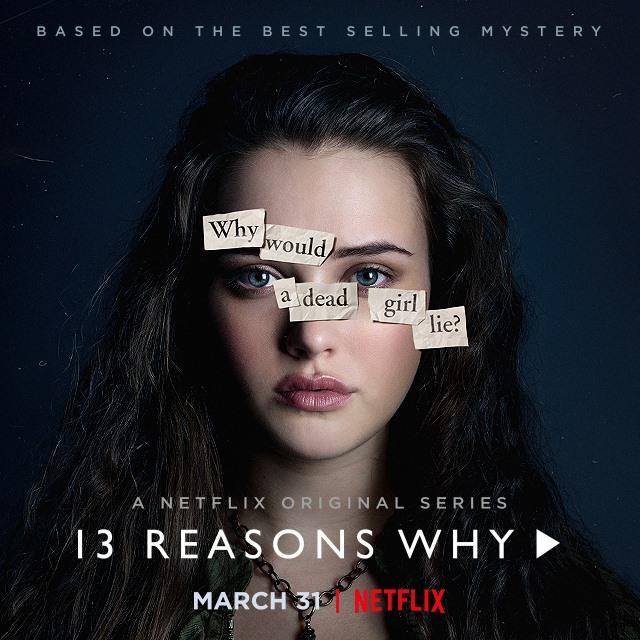The Controversy Behind “13 Reasons Why” A Suicide Story

High school is rough on teens, who have to deal with their changing bodies, fluctuating hormones, peer pressure and the art of walking the fine line between adolescence and adulthood. In early 2017, Netflix released “13 Reasons Why”, a series addressing all of the usual tropes found in teen dramas, and raised the stakes by exploring them through the eyes of teenagers and family members in the aftermath of a girl’s suicide.
The series begins after Hannah Baker, the story’s central character, takes her own life. We experience her side of the story through “flashbacks” edited into the fabric of the story as other characters listen to the 13 audiotapes she recorded prior to her death.
Elements of the story, originally published by Jay Asher as a young adult fiction novel, have set off a rash of protestors from school administrators, mental health professionals, and suicide prevention advocates.
Why is this show so controversial?
Critics claim “13 Reasons Why” inadvertently inspired teens to take their lives
Nobody claims the writers and producers behind the show of purposely sparking a rash of suicides, but the show’s handling of the subject matter may have encouraged at-risk viewers to act on their suicidal impulses. Several school administrators reported spikes in suicidal behavior among their students, and mental health professionals warned parents and teachers to look out for signs of suicidal ideation among the teens in their lives.
Suicide is the third-leading cause of death among Americans between the ages of 10 and 24, according to the US Centers for Disease Control and Prevention.
Mental health advocates and psychologists have suggested that the show hit many of the trigger points associated with suicide “contagion” among persons already struggling with mental illness and the pressures inherent with adolescence and young adulthood.
Reporting on Suicide is an information campaign developed to inform media professionals about responsible coverage and portrayal of suicide in news and entertainment. Their recommendations are based on more than 50 research studies around the world that support the claim that some individuals are susceptible to increased risk of self-harm when exposed to sensationalized, graphic, and repetitious depiction of suicide. According to Reporting on Suicide’s website, “Risk of additional suicides increases when the story explicitly describes the suicide method”.
The Netflix series hit all the triggers, such as focusing on the suffering of mourning families and friends, speculating openly about the victim’s motives and supporting specific events in the subject’s life as being the reason for her suicide. In a dramatic scene, the show doesn’t pull any punches as it depicts the lead character cutting her own wrists with a razor and fading away in her parents’ bathtub. Later, the show depicts the mother’s devastation upon discovering her deceased daughter.
All of these, according to mental health professionals, fuels suicidal ideation.
“13 Reasons Why” portrays suicide as an act of revenge

The story’s central focus is on the tapes, which become a platform for Hannah to exert the power of shame and guilt over those who have harmed her. Offenses vary from fairly common social snubs to violent rape, but the series ignores the fact that up to 90 percent of suicides occur following some level of existing mental illness, including severe depression. While some argue that Hannah Baker’s vengeful plans indicated sociopathic traits, her behavior did not realistically align with the symptoms of serious depression, in spite of the trauma she experienced after being raped.
While people do fantasize about killing themselves as a form of revenge, most who actually end their lives do so for an accumulation of reasons, including a series of perceived social, financial or business failures, a history of mental illness, and inability to cope with the resulting emotional pain.
It seems that most suicides, even by those who suffer from depression, are attempted on impulse. According to a study by Harvard Health Publications, 24% attempt suicide within 5 minutes after the thought and 70% make the attempt within an hour after the initial thought.
Other studies argue that the majority of suicides, while done by impulsive people, are actually planned, but most mental health professionals agree that the motivation for most suicides is the end of emotional pain…not the infliction of pain on others.
“13 Reasons Why” glamorizes and romanticizes suicide
Bethonie Butler of The Washington Post interviewed Dan Reidenberg, executive director of Suicide Awareness Voices of Education (SAVE), who said, “There is a great amount of concern in the suicide prevention community around this series.” Butler wrote, “For Reidenberg, the fact that Hannah gets to tell her story after her death, through the audiotapes, glamorizes the death and sends a potentially dangerous message to viewers.
Indeed, the flashbacks shot from Hannah’s perspective show characters treating her with indifference or even cruelty, whereas after her death, her peers focus on Hannah and their own regrets.
The story martyrs Hannah and criminalizes her peers, further reinforcing the guilt that real-world suicide survivors endure, without shedding light on the psychological issues that also factor in most suicides.
“13 Reasons Why” dismissed adult figures as incapable of providing support

In the wake of the series, the American School Counselor Association developed a webinar, using the show as what it calls a “teachable moment” as other school counselors and psychologists were disappointed and alarmed by the unfair portrayal.
According to the show’s producers, “13 Reasons Why” was meant to shed light on important teen issues, including bullying, gender identity, date rape, and rejection. Sadly, it missed the boat on changing the way we look at suicide and the people left behind, and in some ways, reinforced stereotypes that prevent people from getting or accepting the help they need and deserve. Netflix plans to release a second season in 2018, and critics of the first 13 episodes hope the producers succeed in capitalizing on the show’s success to more carefully, accurately and helpfully portray suicide and other important teen issues.
How to help
If someone you know is expressing suicidal thoughts:
- Do not leave the person alone
- Remove any firearms, alcohol, drugs, or sharp objects that could be used in a suicide attempt
- Call the National Suicide Prevention Lifeline at 1-800-273-TALK (8255)
- Take the person to an emergency room, or seek help from a medical or mental health professional
If someone you know has experienced the loss of a friend, family member, co-worker, or peer to suicide, treat their grief the same as you would any other, with the added understanding that suicide survivors often feel guilt, shame, and anger. Direct them to the American Association of Suicidology’s extensive Resource Page.

In the aftermath of a suicide, who looks after the survivors? Friends and family members need to look after one another and themselves after the loss of a loved one or peer.
Reduce secondary trauma: Do not linger at the setting of a suicide after the deceased has been removed, or take on the responsibility of cleaning up after a traumatic death.
Did your child’s school inform you of a death among the student body? Even if your child claims he hardly knew the deceased, watch for changes in behavior and offer to listen to him if he wants to talk.
Seek out support groups, mental health professionals, and professional suicide cleanup specialists. We at National Crime Scene Cleanup work with your insurance agency, through your municipality’s victim assistance funds, or through private funding arrangements to take responsibility for trauma cleanup off the shoulders of suicide survivors so they can focus on healing and self-care.
Unlike Hannah Baker, your loved one didn’t intend for you to suffer. Call National Crime Scene Cleanup at 1-844-255-2461

